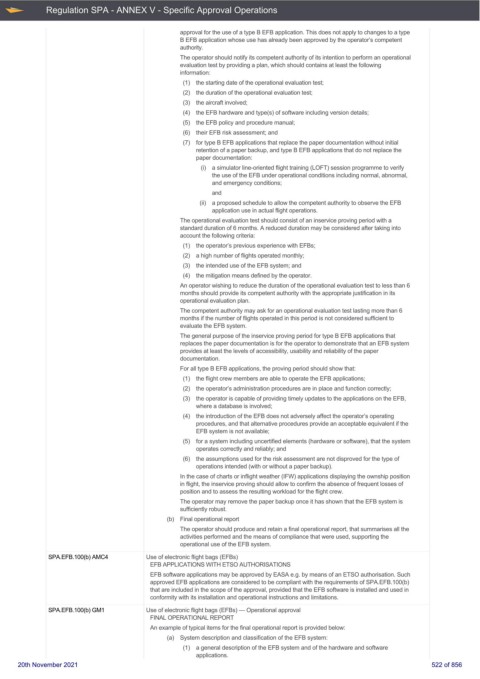Page 522 - UK Air Operations Regulations 201121
P. 522
~
~ Regulation SPA - ANNEX V - Specific Approval Operations Centrik
approval for the use of a type B EFB application. This does not apply to changes to a type
B EFB application whose use has already been approved by the operator’s competent
authority.
The operator should notify its competent authority of its intention to perform an operational
evaluation test by providing a plan, which should contains at least the following
information:
(1) the starting date of the operational evaluation test;
(2) the duration of the operational evaluation test;
(3) the aircraft involved;
(4) the EFB hardware and type(s) of software including version details;
(5) the EFB policy and procedure manual;
(6) their EFB risk assessment; and
(7) for type B EFB applications that replace the paper documentation without initial
retention of a paper backup, and type B EFB applications that do not replace the
paper documentation:
(i) a simulator line-oriented flight training (LOFT) session programme to verify
the use of the EFB under operational conditions including normal, abnormal,
and emergency conditions;
and
(ii) a proposed schedule to allow the competent authority to observe the EFB
application use in actual flight operations.
The operational evaluation test should consist of an inservice proving period with a
standard duration of 6 months. A reduced duration may be considered after taking into
account the following criteria:
(1) the operator’s previous experience with EFBs;
(2) a high number of flights operated monthly;
(3) the intended use of the EFB system; and
(4) the mitigation means defined by the operator.
An operator wishing to reduce the duration of the operational evaluation test to less than 6
months should provide its competent authority with the appropriate justification in its
operational evaluation plan.
The competent authority may ask for an operational evaluation test lasting more than 6
months if the number of flights operated in this period is not considered sufficient to
evaluate the EFB system.
The general purpose of the inservice proving period for type B EFB applications that
replaces the paper documentation is for the operator to demonstrate that an EFB system
provides at least the levels of accessibility, usability and reliability of the paper
documentation.
For all type B EFB applications, the proving period should show that:
(1) the flight crew members are able to operate the EFB applications;
(2) the operator’s administration procedures are in place and function correctly;
(3) the operator is capable of providing timely updates to the applications on the EFB,
where a database is involved;
(4) the introduction of the EFB does not adversely affect the operator’s operating
procedures, and that alternative procedures provide an acceptable equivalent if the
EFB system is not available;
(5) for a system including uncertified elements (hardware or software), that the system
operates correctly and reliably; and
(6) the assumptions used for the risk assessment are not disproved for the type of
operations intended (with or without a paper backup).
In the case of charts or inflight weather (IFW) applications displaying the ownship position
in flight, the inservice proving should allow to confirm the absence of frequent losses of
position and to assess the resulting workload for the flight crew.
The operator may remove the paper backup once it has shown that the EFB system is
sufficiently robust.
(b) Final operational report
The operator should produce and retain a final operational report, that summarises all the
activities performed and the means of compliance that were used, supporting the
operational use of the EFB system.
SPA.EFB.100(b) AMC4 Use of electronic flight bags (EFBs)
EFB APPLICATIONS WITH ETSO AUTHORISATIONS
EFB software applications may be approved by EASA e.g. by means of an ETSO authorisation. Such
approved EFB applications are considered to be compliant with the requirements of SPA.EFB.100(b)
that are included in the scope of the approval, provided that the EFB software is installed and used in
conformity with its installation and operational instructions and limitations.
SPA.EFB.100(b) GM1 Use of electronic flight bags (EFBs) — Operational approval
FINAL OPERATIONAL REPORT
An example of typical items for the final operational report is provided below:
(a) System description and classification of the EFB system:
(1) a general description of the EFB system and of the hardware and software
applications.
20th November 2021 522 of 856

